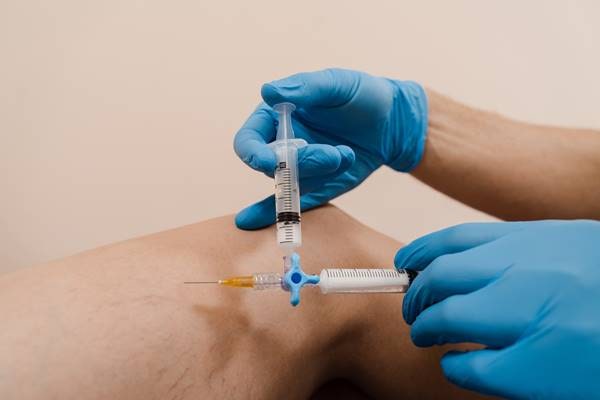Foam sclerotherapy is a minimally invasive treatment for varicose veins that involves injecting a foam solution directly into the affected vein. The foam solution is created by mixing a liquid sclerosant with air or gas, which creates a foam that can better adhere to the vein walls and stay in place for longer periods of time. Once injected, the foam irritates the inner lining of the vein, causing it to collapse and eventually be absorbed by the body.
Foam sclerotherapy has been found to be highly effective in treating small to medium-sized varicose veins, as well as spider veins and other superficial venous disorders. It is often used as an alternative to more invasive treatments such as surgery or laser therapy.

How Does Foam Sclerotherapy Work?
Foam sclerotherapy is a minimally invasive treatment for varicose veins that involves injecting a foam solution directly into the affected vein. The foam is made by mixing a liquid sclerosant with air or another gas, which creates a thick, frothy substance that can be easily seen on ultrasound imaging. Once injected into the vein, the foam displaces blood and irritates the inner lining of the vessel, causing it to collapse and stick together.
This process ultimately leads to the closure of the vein and rerouting of blood flow through healthier vessels in the leg. Foam sclerotherapy can be highly effective in treating varicose veins and may offer benefits such as reduced pain and faster recovery times compared to traditional surgical options.
Who Is A Candidate For Foam Sclerotherapy?
This procedure is suitable for most patients with varicose veins, including those with large, twisted, or bulging veins. However, it may not be recommended for individuals with severe underlying medical conditions or those who are pregnant or breastfeeding.
Additionally, foam sclerotherapy may not be effective for treating certain types of varicose veins that are located deep within the leg muscles.
Overall, the best way to determine if you are a good candidate for foam sclerotherapy is to schedule a consultation with a qualified vascular specialist who can assess your unique needs and help you choose the most appropriate treatment plan.
What Are The Benefits Of Foam Sclerotherapy?
Foam sclerotherapy is a minimally invasive treatment for varicose veins that has become increasingly popular in recent years. One of the main benefits of foam sclerotherapy is its high success rate, with up to 90% of patients experiencing significant improvement in their symptoms.
It is also a relatively quick procedure that can be performed in an outpatient setting, which means that patients can usually return to their normal activities the same day.
In addition, foam sclerotherapy does not require general anesthesia or incisions, which reduces the risk of complications and shortens recovery time.
Finally, foam sclerotherapy has been shown to be effective for a wide range of vein sizes and locations, making it a versatile treatment option for many patients.
What Are The Risks And Side Effects Of Foam Sclerotherapy?
As with any medical procedure, foam sclerotherapy for varicose veins carries some risks and potential side effects.
One of the most common side effects is temporary discomfort or pain at the injection site. Some patients may also experience bruising, swelling, or itching in the treated area. In rare cases, allergic reactions to the sclerosant foam may occur. There is also a small risk of blood clots developing in deeper veins after treatment.
In very rare cases, skin ulcers or nerve damage may occur. It is important for patients to discuss their medical history and any current medications with their doctor before undergoing foam sclerotherapy to minimize these risks and ensure a safe and effective treatment outcome.
How To Prepare For A Foam Sclerotherapy Procedure
Before undergoing foam sclerotherapy for varicose veins, there are several steps you should take to prepare for the procedure.
It is recommended to avoid any blood-thinning medications or supplements, such as aspirin or fish oil, for at least a week before the treatment. You should also wear loose-fitting clothing and comfortable shoes to your appointment.
It is important to inform your healthcare provider of any allergies or medical conditions you may have, as well as any medications you are currently taking.
Additionally, it is advisable to arrange for transportation home after the procedure, as walking may be uncomfortable immediately following treatment. By taking these precautions and following your healthcare provider’s instructions, you can ensure a safe and successful foam sclerotherapy procedure.
What To Expect During And After A Foam Sclerotherapy Treatment
During a foam sclerotherapy treatment, patients can expect to feel a mild discomfort or stinging sensation as the foam solution is injected into the affected veins.
The procedure typically takes 30-60 minutes to complete, depending on the number of veins being treated. After the treatment, patients may experience some bruising, swelling, or soreness around the injection site. It is recommended to wear compression stockings for several days after the procedure to aid in healing and prevent blood clots from forming.
Patients should avoid strenuous activities for a few days and refrain from taking hot baths or using saunas for at least two weeks. It may take several weeks for full results to be seen, and multiple treatments may be necessary depending on the severity of the varicose veins.
Is Foam Sclerotherapy The Right Choice For You?
This procedure is often recommended for patients with small or medium-sized varicose veins, as well as those who cannot undergo surgery due to medical reasons.
However, it is important to note that not everyone is a good candidate for foam sclerotherapy. Patients with large or twisted varicose veins may require other treatments such as endovenous laser therapy (EVLT) or surgical procedures.